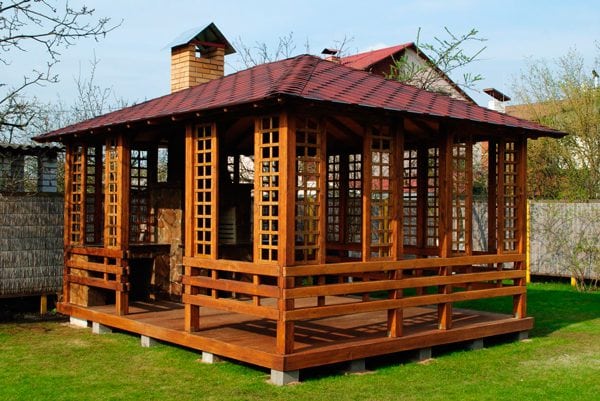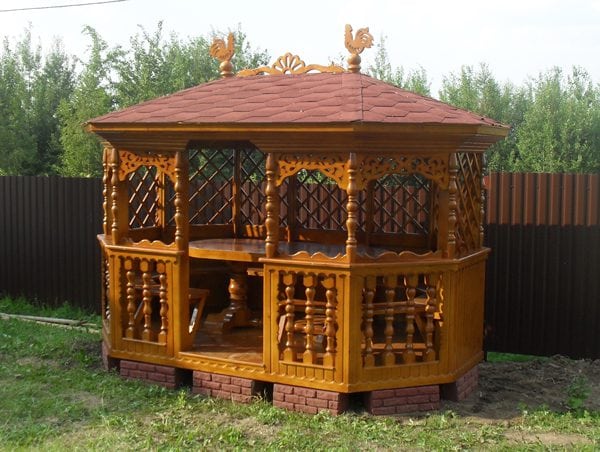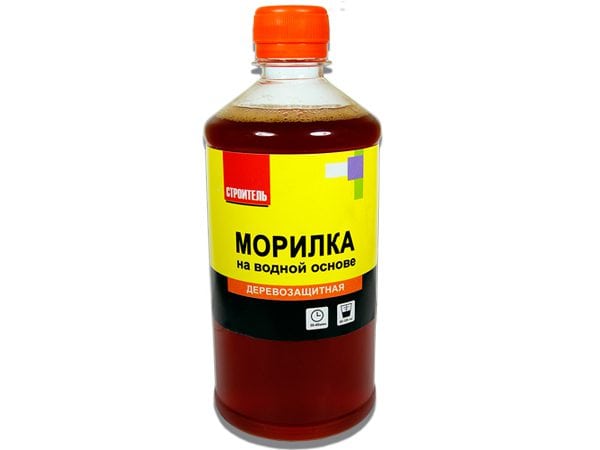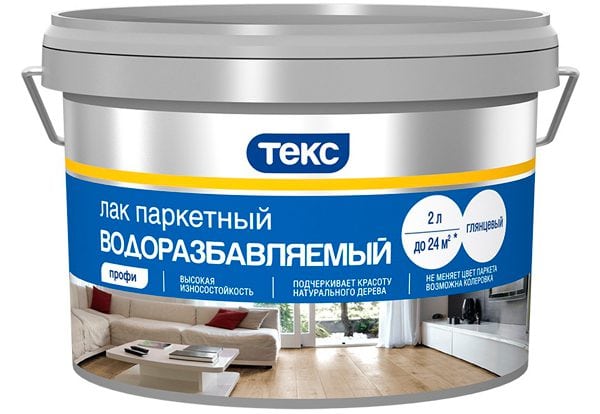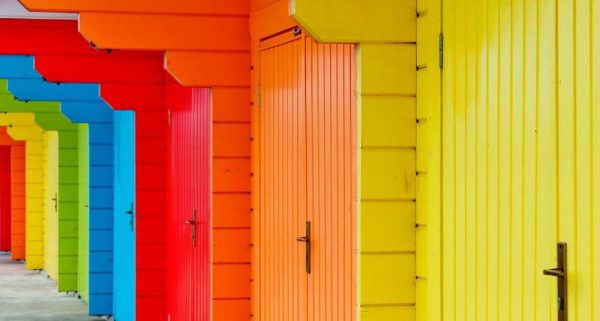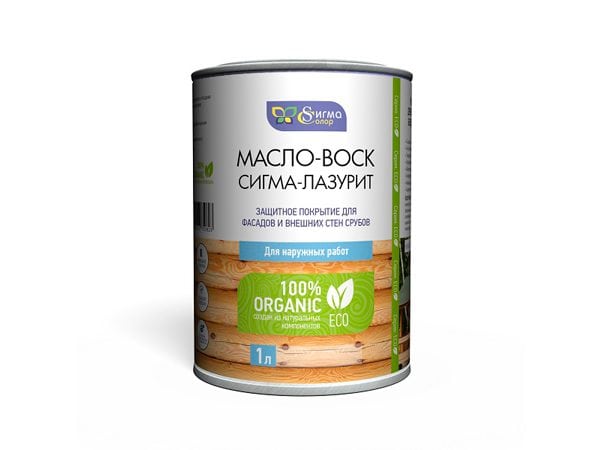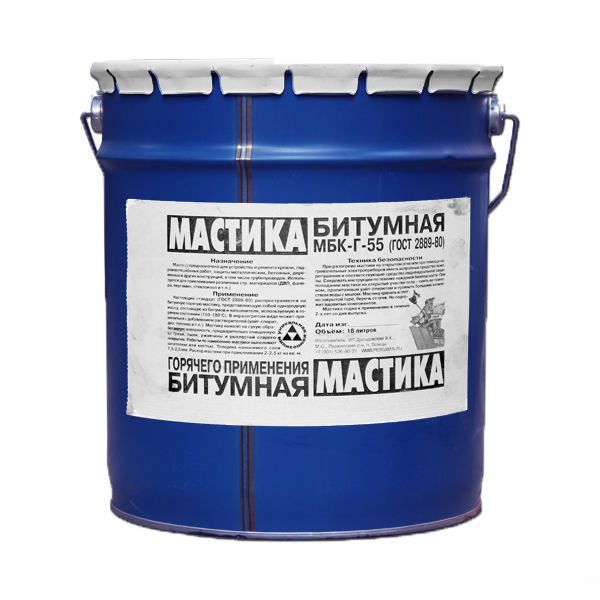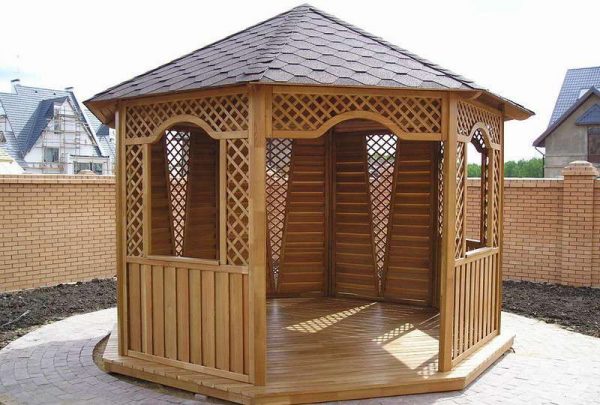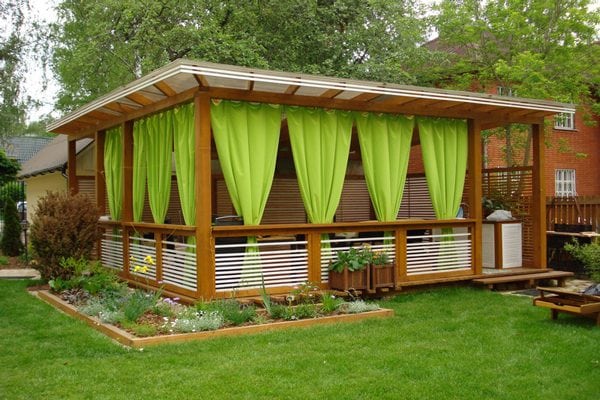Sooner or later, the question of how to paint the gazebo on your site, arises from every summer resident. If you look at the building catalogs, there are a lot of paints and varnishes there, and it is very difficult to determine which is better to use to protect the building from the effects of atmospheric precipitation, how to make it beautiful for a long time.
- The condition of the board matters
- Protective coatings and paints for gazebos
- Transparent means
- Water
- Oil
- Varnish
- Case (opaque) coatings
- Covering the gazebo floor with varnish and mastic
- Cold mastics
- Hot mastics
- Lucky
- Color is important
- Tint
- Dyeing
- Drawings
- Features of finishing work
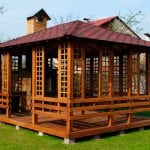
The condition of the board matters
When deciding how to paint a wooden arbor, it is necessary to inspect the condition of the wood, because when choosing a varnish or paint, this parameter plays an important role:
- New polished board. Smooth wood can be coated with clear varnish, stain or other tinting compounds. The processed wood looks beautiful, and it is better to emphasize its unique structure with clear paint.
- Untreated wood. Transparent compositions for poorly trimmed boards are best avoided. The paint will lie unevenly: it will shine on the smoother areas, and the rough ones will get a matte shade, and the stains from the painting tool (if a roller or brush was used) will always remain. It is better to use opaque dyes for painting raw wood and apply them with a spray gun.
- Old, darkened tree from time to time. For such a surface of the gazebo, you can use only opaque paint, which will hide all defects.
- Painted but lost-looking wooden gazebo. If it is planned to paint over the old coating, it is better to select the paint that matches the composition previously applied. But this method of coloring the gazebo is not recommended - the remains of the old dye will reduce the protective properties of the applied composition, and soon, under the influence of atmospheric precipitation and other adverse factors, the decorative coating will begin to peel off. The remnants of old paint are recommended to be completely removed, and wooden surfaces should be treated with protective agents before painting.
Having decided on the type of surface, you can proceed to the choice of a coloring agent.
to contents ↑Protective coatings and paints for gazebos
There are various types of coatings that can be used for painting garden gazebos.
Transparent means
On the basis of artificial resins, primers and other transparent coatings are produced that can be diluted with water or solvents.
Water
Several types of soil are made on water:
- Latex. They are distinguished by deep penetration, they do not reduce the vapor permeability of the base, they do not pass moisture into the tree. Before applying the primer, thorough surface preparation must be done so that adhesion is sufficient and dust is absent. Latex primers are most often used for painting wooden arbors.
- Acrylic They have the ability to penetrate deeply into the base.Enriched with antiseptic and fungicidal additives, help protect wood from damage, lower paint consumption if paintwork is applied with a second coat.
- Stains. Contain alcohol, modifiers, pigments, can be applied to smooth surfaces that have been polished. It is advisable to perform another layer of transparent protective agent after the stain layer has been completed.
Oil
Different drying oils are the cheapest and most popular among oil coatings. It is better not to use them as fixed assets - after drying, stickiness remains, so oil paints are usually diluted with drying oils. Without staining and varnishing, the surface under drying oil will quickly become dirty, ugly.
Pinotex primers are classified as oil coatings - they are made from pigments and alkyd resins. If the product contains chlorophenols, coatings are suitable only for outdoor use. Such materials are mainly produced in Eastern Europe and the Baltic states. It is important to apply Pinotex only on a special primer, otherwise the oil will snap off after a year or a little more.
Varnish
Varnishes have a transparent structure, they contain solvents, resins and other necessary components. The main types of varnishes:
- Toning. They are used if it is required to change the color of wood, emphasize its structure. Apply a new coat of varnish only after the previous one has completely dried. The composition contains organic solvents, because the means are harmful to humans. The disadvantages of varnishes are significant: complex application, detachment from the base when in contact with water, turbidity over time. If you want to change the type of varnish, you will have to completely remove the old layer, otherwise the new varnish will not fall.
- Yacht, parquet. They do not have moisture resistant colors. They can be glossy, matte, semi-gloss. The composition has a number of improving additives, including making the varnish resistant to UV rays. The service life of the layer of yacht varnish is quite high - up to 5 years or more.
Case (opaque) coatings
Needed for solid wood coloring. Such enamels are used for outdoor work, include modern components - polymers. Basic types of paints:
- Acrylic Very durable, diluted with water, environmentally friendly, not harmful to humans. Latex may be present in the composition - then an elastic film will be created on the surface of the base, preventing water from entering and mechanical damage.
- Silicone Composed of silicone and silicon components, resins. Water-resistant paints, but do not reduce the breathability of wood. A distinctive property is that the material layer after drying of the paint will not be prone to dust, dirt (the so-called self-cleaning coatings).
- Silicate. The composition is represented by the main component - potassium glass, which gives enhanced moisture resistance. The disadvantages include the lack of the ability to apply silicate paint to other types of materials - they will have to be completely removed.
- Alkyd. Based on glyptal and pentaphthalic varnishes, resistant to atmospheric factors, durable, but expensive. It is necessary to dilute such products with white spirit and other solvents, therefore it is better to use them for external work.
Covering the gazebo floor with varnish and mastic
In addition to primers, it is possible to apply the technique of varnishing or coating with mastic compounds that help preserve the natural appearance of wood, provide protective properties. Mastics differ in composition and temperature of application.
The advantages of mastics include the ability to update the layer on top of the old one - varnishes can not be applied this way. But mastics should be regularly rubbed if it is required to maintain the gloss at the proper level. Lucky is easier to maintain.
to contents ↑Cold mastics
Such mastics are intended for application without prior heating. May be as follows:
- water-soluble - environmentally friendly, used on a dense type of wood, but react poorly to the presence of water;
- water-emulsion - easy to apply, universal, self-cleaning;
- turpentine and resin - include appropriate additives, paraffin, give a beautiful shine to the tree;
- Wax - based on beeswax, suitable for all types of wood.
Hot mastics
These funds are applied after heating to +180 degrees, gain hardness and basic properties after cooling. Mastics are dangerous, in domestic conditions due to the risk of ignition are not used. Depending on the composition, rubber and bitumen are distinguished among hot mastics.
to contents ↑Lucky
The varnish consists of natural and artificial resins with various additives. Varnishes for outdoor work necessarily contain anti-fungal, ultraviolet components that enhance water resistance.
Color is important
All kinds of color combinations are suitable for painting the gazebo. The main requirement is that the structure should fit seamlessly into the surrounding landscape. You can emphasize the beauty of the gazebo in two ways:
- giving the basis of a shade;
- staining.
Tint
This is achieved using tint mixtures:
- Transparent, allowing you to preserve the unique texture of the tree and emphasize the beauty of the structure with the help of shine of varying intensity. Colorless varnishes are suitable only for polished timber.
- Toning. Transparent varnishes with the addition of a tinted pigment or stain emphasize the beauty of a wooden base. They should be applied only to smooth new substrates.
Dyeing
If you completely paint the gazebo in a dark color, it will look gloomy. Experts always advise playing in contrast: add light colors, for example, make the frame dark, the roof light. The gazebo in bright colors looks attractive and fresh. Looks great beige, yellow, light wood tone. Such shades play beautifully in the sun.
Painting the gazebo can be done in any color - in the store it is easy to pick up all kinds of shades for painting. The most popular colors are:
- White. Makes the building visually easier, creates a feeling of spaciousness and light. Minus: quickly under the influence of ultraviolet gets an unpleasant yellowish tint. For street coatings, it is recommended to use not white, but pastel colors.
- Yellow. All sorts of soft shades of yellow are recommended when you want to create the illusion of a wood base.
- Green or blue. They are considered the most unsuitable for painting the surface of a tree, but at the same time they are most often used. If such a color combination fits into the design, then you can paint in these colors.
- Red. Dark red or red brown should only be used for the floor in the building. Wall surfaces and the roof should not be painted in dark colors - a feeling of heaviness of the structure will be created.
But these are only approximate recommendations, and everyone must decide what color to paint the building on his site.
to contents ↑Drawings
Typically, the technique is used for coloring children's arbors. Drawings in the form of fairy-tale characters, animals or other decorations are placed on the outside of buildings to attract the attention of the child. For children's arbors such colors are used as white (gives purity, brightness), lime, lemon, red, various pastel shades.
Features of finishing work
Painting the gazebo is no different, only when working on the street you must always take into account the drying time of the paint and choose warm, dry weather. Finishing work consists of the following steps:
- Cleaning up. The surface must be cleaned of contaminants. Pieces of resin and residual old paint that interfere with good adhesion during painting should be removed.
- Impregnation. Impregnating solutions will protect the wood structure from fungus, rot and fires, which are most dangerous for this material.Impregnation with a roller or brush is spread over the surface and left to dry completely. It is permissible to skip the impregnation step when using a primer that contains the necessary protective additives.
- Priming. Some masters ask the question: “Do I need to be primed or not?” This question can be answered that it is necessary to prime when it is necessary to achieve a strong protective coating of the building. The primer is applied in 2-3 layers, and the subsequent layer is applied only after the previous one dries.
- After the soil has dried, decorative painting is performed, which begins from the ceiling, then the walls are painted, and then varnish or floor mastic is coated.
First, the inner surfaces are painted, and then the gazebo is painted on the outside in compliance with the same sequence of steps.
Having chosen the paint to your taste and in accordance with the purpose (for walls or floors), as well as having decided on the color, you can give your arbor a cozy and attractive look for a long time.

